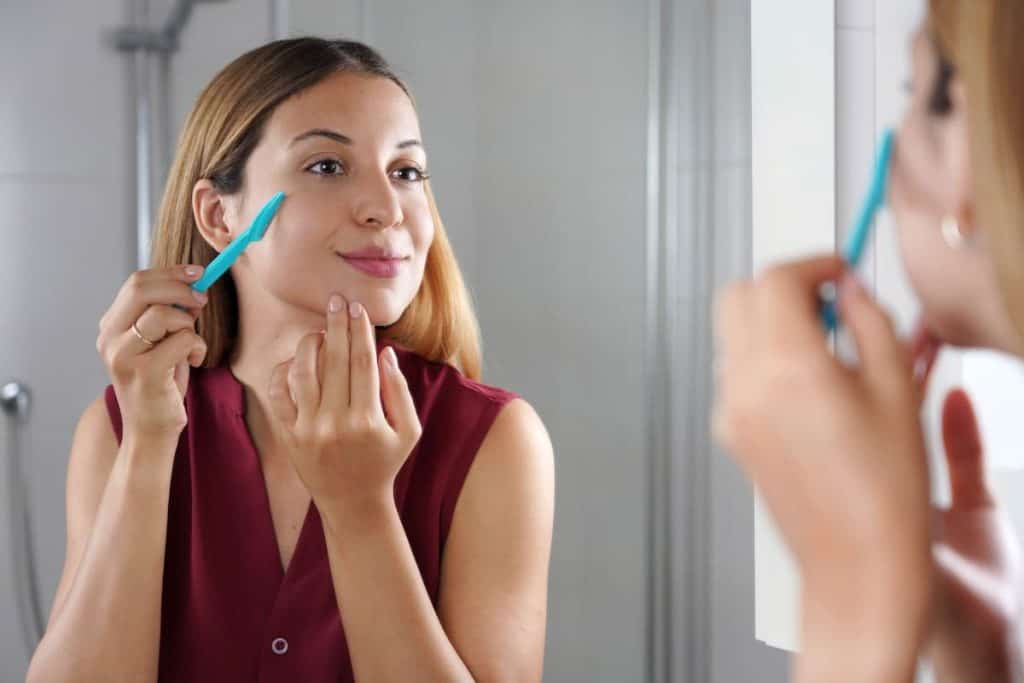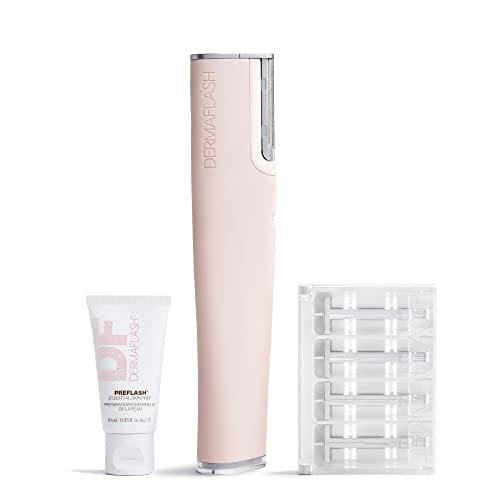Dermaplaning vs. Shaving: Are They the Same?
This post may contain affiliate links, which means I may receive a small commission, at no cost to you, if you make a purchase.
There’s nothing wrong with having facial hair. But there’s also nothing wrong with wanting to get rid of excess amounts of it, especially if it makes you feel less confident.
The problem is that peach fuzz can be painful and difficult to remove, even with popular methods like waxing.

As such, many people opt for the pain- and hassle-free technique of shaving it off themselves.
Lately, though, there’s been a new term gaining traction as a must-try facial hair removal technique: dermaplaning.
As dermaplaning continues to trend on several online platforms, more beauty enthusiasts are becoming curious about this cosmetic procedure.
They often compare it to shaving because the two techniques appear similar to each other. But they actually serve completely different functions.
And to be able to maximize their benefits, it’s crucial to understand what distinguishes them from each other.
In this article, we’ll discuss everything you need to know about dermaplaning vs. shaving and help you find out which one is right for you.
Table of Contents
- 1 Is Dermaplaning the Same as Shaving?
- 2 Is Dermaplaning Better than Shaving?
- 3 Pros of Dermaplaning
- 4 Cons of Dermaplaning
- 5 Step-by-Step Guide to Dermaplaning at Home
- 6 What To Avoid After Dermaplaning at Home
- 7 5 Best Tools for Dermaplaning at Home
- 8 Frequently Asked Questions
- 9 Dermaplaning vs. Shaving: The Choice Is Up to You
- 10 Authors
Is Dermaplaning the Same as Shaving?
The short answer is that it isn’t.
Dermaplaning, on the other hand, is a minimally invasive cosmetic procedure that exfoliates the skin. The main goal is to remove the uppermost layer of the epidermis.
Dermatologists and licensed aestheticians use a dermatome or a surgical-grade blade to slough off dead skin cells from your pores. DIYers achieve this feat by using a special dermaplaning razor or blade.
During the process of exfoliation, small, fine hairs are also removed from the face.
Dermaplaning and shaving only appear similar because they’re both used for the removal of facial hair, which is also known as vellus hair or peach fuzz.
So how is dermaplaning different from shaving? The quickest way to tell them apart is by looking at each method’s underlying goal or purpose.
With shaving, the main goal is to remove hair. You typically use a single-blade or multi-blade razor, then gently glide it onto the skin to cut off visible hair.
Simply put, hair removal is simply one of the perks of dermaplaning and not the sole objective of the procedure.
Is Dermaplaning Better than Shaving?
Dermaplaning offers a few more benefits than shaving.
Not only does it remove dead skin cells that clog your pores and dull your skin, but it also acts as a skin resurfacing treatment that can
- reduce the appearance of acne scars, pitted skin, and hyperpigmentation;
- minimize the appearance of fine lines and wrinkles;
- even out skin tone and texture;
- reveal a brighter and younger-looking complexion;
- provide silky-smooth and firmer skin;
- improve the skin’s absorption of skincare products; and
- facilitate a smooth and seamless makeup application.
But while dermaplaning has additional skin benefits, these don’t automatically make it better than shaving. It still depends on your skin’s needs and what kind of results you want to achieve.
For instance, dermaplaning is not suitable for those with sensitive skin or a compromised skin barrier since it can cause irritation or lead to additional skin damage.
If you’re already doing other resurfacing treatments, dermaplaning may also cause over-exfoliation that can leave your skin dry and dehydrated.
In these cases, shaving may be the more ideal option for you.
Pros of Dermaplaning
Not sure whether dermaplaning is right for you? We’ve listed the pros and cons of dermaplaning below to help you weigh your options.
Closer Shave
If your main goal is to remove vellus hair or peach fuzz, dermaplaning may provide better results than shaving.
This is because dermaplaning with a razor will give you a closer shave. It removes the outermost layer of the epidermis and cuts closer to the skin, making it extremely thorough at hair removal.
Whereas with shaving, a razor only cuts facial hair at the surface level. The shave is also blunter, resulting in that stubble feeling or rough sandpaper texture to your skin.
Fast and Easy Process
Dermaplaning only takes about 15 to 30 minutes. If you go to a licensed professional, dermaplaning will be a painless and convenient experience.
No Downtime
Compared to other resurfacing procedures like microdermabrasion and chemical peels, dermaplaning has no downtime.
There may be some redness or tenderness right after the procedure, but nothing will prevent you from going about your day.
Exfoliation Benefits
As previously mentioned, dermaplaning also delivers top-notch exfoliation that shaving can’t provide.
So aside from keeping your face fuzz-free, it also helps reveal fresh, smooth, bright, and beautiful skin!
Plus, it also gives you a clean base that allows you to maximize the benefits of your skincare and makeup products.
Cons of Dermaplaning

Not For Everyone
Unfortunately, dermaplaning is not suitable for everyone. Despite being minimally invasive, this cosmetic procedure is not recommended for those with the following skin conditions:
- Active, pustular acne
- Cold sores
- Contact dermatitis or skin rashes
- Eczema
- Psoriasis
- Dark, thick facial hair
This is because the process can irritate skin that is already sensitive to begin with.
Dermaplaning may also nick active pustular acne, which can cause bacteria to spread to different areas and further irritate the skin.
Dermaplaning is also not recommended for areas with moles and skin tags.
People with thicker, darker facial hair are also discouraged from getting dermaplaning because they’re at a higher risk of getting ingrown hairs from the procedure.
Temporary Results
Dermaplaning only offers temporary hair removal; it does not permanently stop hair growth. This means you’ll have to go through regular dermaplaning sessions to keep peach fuzz at bay.
If you want longer-lasting results, you may want to explore long-term hair removal solutions like electrolysis and laser hair removal.
Expensive Price
To take full advantage of the benefits this treatment offers, you’ll need to return to your dermatologist or aesthetician for dermaplaning sessions every four to six weeks.
Given that the cost of each dermaplaning session is around $75 to $200, it’s definitely pricier than a simple shave.
If you’re using it for skin rejuvenation purposes, you may end up spending more on it than similar treatments like laser resurfacing.
Potential Safety Risks
Dermaplaning should be done by a licensed professional. Otherwise, you may be exposed to potential safety risks.
After all, dermaplaning involves putting a sharp blade very close to the face. Without proper training or experience, you may end up cutting yourself.
This can lead to scarring, hyperpigmentation, and infection. The latter is even more likely if you do not properly sanitize your tools.
That said, it’s still possible to perform dermaplaning on your own! Just remember to consider these safety risks and take proper precautions to avoid them.
Keep in mind as well that the results may also not be as smooth and precise as when done by a professional.
If your heart is set on trying out dermaplaning at home, we’re here to help. We’ll give you tips on how to dermaplane on your own safely and effectively in the next section.
Step-by-Step Guide to Dermaplaning at Home
Whether you want a quick touch-up between dermaplaning sessions or try out DIY dermaplaning, be sure to follow the steps below to help you make the most out of the procedure and minimize safety risks.
Get a Well-Sanitized Dermaplaning Tool
Make sure to use a fresh blade and sanitize it properly to minimize the risk of infection or irritation.
Clean and Prep Your Skin
Use a gentle cleanser to remove germs, bacteria, dirt, and pollutants from your skin.
Use a Toner and Dermaplaning Oil
Follow this up with a gentle toner to remove excess oil and close up your pores.
Experts also recommend applying a nourishing and hydrating oil like the QRxLabs Squalene Oil before dermaplaning, especially if you have dry or sensitive skin.
This ensures gentler exfoliation, helps the blade glide smoothly across the skin, and reduces the risk of getting cuts or nicks.
Hold the Blade at an Angle
As you begin dermaplaning, make sure to hold your skin taut with one hand. Position the blade at a 45-degree angle to the skin with your other hand.
Make Short, Feathery Strokes
Begin by making short, light strokes in a downward motion from the top of your ear, slowly moving toward the center of your face. Avoid delicate areas like the eyes, nose, and mouth.
Continue until you have gone through your cheeks, jawline, upper lip, and other major areas of the face. It’s also best to glide the blade in the direction of your hair growth to prevent irritation or ingrown hair.
Rinse and Apply Skincare Products
Splash your face with water and pat dry.
Since dermaplaning removes the outermost layer of the epidermis, your skin barrier may be sensitive during this time. So make sure to follow up the procedure with soothing and hydrating skincare products.
Use serums or moisturizers with ceramides or hyaluronic acid to prevent dryness and irritation. You can also opt for calming ingredients such as aloe, green tea, and chamomile.
What To Avoid After Dermaplaning at Home
To prevent irritating or damaging your skin after dermaplaning at home, follow the safety precautions listed below.
Avoid Sun Exposure
Harmful UV rays can do much more damage when you have a vulnerable skin barrier. If you can’t avoid being out in the sun, make sure to wear sunscreen for added protection.
Don’t Use Skincare Products With Harsh Ingredients
These include products that contain acids, retinol, exfoliants, and alcohol.
Avoid using these for three to five days. Once your skin is no longer sensitive and new skin has resurfaced, you can go back to your usual skincare routine.
Steer Clear of Heat, Water, and Vigorous Physical Activity
Avoid swimming in chlorine pools, steaming or going to the sauna, and engaging in intense physical activity for three to five days.
Performing these activities while your skin is still in the process of healing and regenerating may lead to irritation and infection.
5 Best Tools for Dermaplaning at Home
Now that you understand the differences between dermaplaning vs. shaving and the proper safety precautions, here are the best dermaplaning tools you can use at home.
This razor is sharp enough to remove facial hair but safe enough to use for dermaplaning at home.
Key benefits: gentle exfoliation of dead skin cells; easy hair removal
Features:
- Stainless steel blade is durable and rust-resistant
- Includes a safety cap to prevent nicks and cuts
- Blade length at 1.37 inches, which is longer than most eyebrow razors
The Tweezerman Facial Razor provides the closest shave you can get when dermaplaning at home.
It may look like your ordinary eyebrow razor, but the Tweezerman Facial Razor is specifically designed for dermaplaning.
It has a longer blade, allowing you to gently exfoliate the topmost layer of the skin. The handle is also longer to give you a strong and stable grip throughout the process.
Take note, though; the blade is very sharp. It is not recommended for beginners who do not have dermaplaning experience.
The perfect tool for DIY dermaplaning, this wand helps you achieve professional results.
Key benefits: Easy removal of fine hairs; reveals smooth and radiant skin
Features:
- Blade has micro-guards to prevent nicks and irritation
- Non-slip silicone grip and curved handle for precise control
- Comes with six refill blades
Made with beautiful rose gold metal, this dermaplaning tool is sure to become a staple in your skincare routine.
The Schick Hydro Silk Dermaplaning Wand is an attractive and incredibly effective dermaplaning tool. It gently exfoliates delicate facial skin to remove peach fuzz and reveal smooth, glowing skin.
With a non-slip grip and curved handle, it’s so easy to use. Even beginners will be able to enjoy the benefits of dermaplaning at home with this wand.
This dermatologist-approved dermaplaning tool is also convenient to bring along with you wherever you go — so you can keep up your dermaplaning routine on the go!
The Dermaflash Luxe+ offers spa-like hair removal at home.
Key benefits: Safely and gently exfoliates dead skin cells; helps you achieve smooth, fuzz-free skin instantly
Features:
- Sonic vibrations for effortless exfoliation and hair removal
- Microfine edge protects against nicks and scrapes
- Award-winning technology improves skin texture over time
Let this tool do all the work in giving you smooth, flawless skin!
The Dermaflash Luxe+ is more than just a razor. It utilizes sonic edge technology to deliver precise exfoliation and hair removal while prioritizing your safety and comfort.
Besides giving you quick results, it also helps improve your skin over time. With regular use, you’ll get youthful and radiant skin.
However, the Dermaflash Luxe+ doesn’t come cheap. It can be a good investment for those who get regular dermaplaning sessions throughout the year.
Even beginners can experience smooth and fuzz-free hair with the JasClair dermaplaning tool kit.
Key benefits: Safe and effective exfoliation and hair removal; easy to use
Features:
- Durable stainless steel blade with chrome and Teflon coating
- Sharp teeth ensure precise results while keeping your skin safe from damage
- Foldable blade allows for practical hair removal on the go
Even if it’s your first time dermaplaning on your own, you can achieve precise results with this tool and enjoy smooth and flawless skin.
The JasClair Dermaplaning Tool Kit aims to make the dermaplaning process as easy and effortless as possible for beginners and pros alike.
Made with durable stainless steel, its stamped blade is designed with fine teeth to ensure that you have a safe, ultra-precise hair removal experience. It also exfoliates your skin, removing dead skin cells and other impurities.
Best of all, it’s compact and travel-friendly, making it the perfect tool for last-minute dermaplaning.
This gentle but effective exfoliating tool will give those with dry and sensitive skin confidence to dermaplane at home.
Key benefits: Removes dry skin and peach fuzz instantly; reveals a smooth and radiant appearance
Features:
- Surgical stainless-steel blade for professional results
- Lightweight design with a comfortable handle for great grip and control
- Available in two blade sizes to match your dermaplaning needs
Designed with sustainability in mind, you’ll surely feel good using the Stacked Skincare Dermaplaning Face Exfoliating Tool.
Itching for a professional dermaplaning session but don’t have enough time in your schedule? Then consider the Stacked Skincare Dermaplaning Face Exfoliating Tool.
It features a surgical stainless steel blade that can exfoliate dead skin cells and remove peach fuzz. It’s also gentle enough for those with sensitive skin.
The aluminum handle is designed for lifetime use. You only need to replace the removable blade for hygienic purposes.
Although this face exfoliating tool is pricier, its ability to deliver professional-level dermaplaning results is unrivaled.
Frequently Asked Questions
Can You Use a Regular Razor for Dermaplaning?
No. Regular razors cannot exfoliate the skin, making them unsuitable for dermaplaning.
Make sure to choose a single-blade tool specifically designed for dermaplaning if you want to enjoy all the benefits the procedure offers.
Does Dermaplaning Make Your Face More Hairy?
Contrary to popular belief, dermaplaning will not make your facial hair thicker, darker, or pricklier.
Dermaplaning cannot affect hair growth since it does not remove hair at the roots. After dermaplaning, your facial hair will grow back with the same texture and color.
How Long Do Dermaplaning Results Last?
Dermaplaning results last about three to four weeks. After this time, you can expect visible hair growth and dead skin cell buildup, indicating that you need another dermaplaning session.
How Often Should I Dermaplane?
Experts recommend dermaplaning only once a month. Since dermaplaning is a resurfacing treatment, you want to give your skin enough time to recover in between sessions to prevent irritation.
However, this may also depend on specific factors such as your hair regrowth cycle and skin type. So it’s best to work with your dermaplaning technician to create a customized dermaplaning schedule that accommodates your needs.
What Happens If You Dermaplane Too Often?
Dermaplaning can cause over-exfoliation, which can damage your skin barrier and lead to dryness, fine lines, wrinkles, itch, redness, and irritation.
Dermaplaning vs. Shaving: The Choice Is Up to You
Is dermplaning shaving? Now you know that the answer is no!

Also, now that you’re familiar with the differences between dermaplaning and shaving, you can decide which hair removal method is right for you.
Remember that it’s best to go for shaving if you want quick results or if you have acne or any other skin condition that may be exacerbated by dermaplaning.
But if you want to get a procedure that provides a closer shave while giving you smoother, brighter, and younger-looking skin, go ahead and hop on the dermaplaning bandwagon!
Want To Learn More About Hair Removal Procedures?
Check out these articles:







